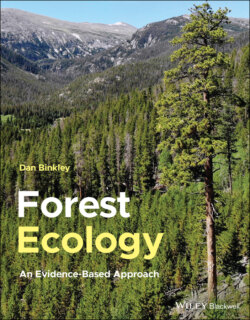Читать книгу Forest Ecology - Dan Binkley - Страница 49
Ecological Afterthoughts
ОглавлениеThe major tree species of the Rocky Mountains in the USA can be plotted in two‐dimensional space of average annual temperature, and average annual precipitation (Figure 2.23). The points represent the environment where each species currently shows its highest frequency of occurrence, and the oval clouds represent the full range of species occurrences (based on 9500 plots across the region). The overlap of ranges makes it hard to see separate species, but it paints a picture of how similar (but not identical) the distributions of species may be. The environment where each species has its peak of occurrence is not in the middle of the species' oval (lower graph). Plots like these represent how two features covary, but not whether one or both factors actually drive the pattern (correlation should not be confused with strong evidence of causation). Do the species ranges likely result from direct effects of temperature and precipitation? If not, what other factors might be important? The ranges for the species could be coupled with climate simulation models, with the output showing the geographic locations where each species might be expected to be found. What limitations would be important in how well such stories would actually map onto real landscapes? How would the factors on such a list of limitations interact, and what would the implications be for the interactions?
FIGURE 2.23 The major tree species in the Rocky Mountains, USA can be plotted in relation to where they are most frequent on axes of temperature and precipitation (upper left, based on 9500 locations). The full range of occurrence can be plotted as overlapping clouds (which are difficult to decipher for any single species in the upper‐right graph). The points of maximum frequency for each species does not fall in the middle of each species' range (lower graph;
Source: Data from Martin and Canham 2020).
